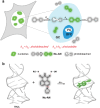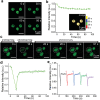Rna Buffering Fluorogenic Probe for Nucleolar Morphology Stable Imaging And Nucleolar Stress-Generating Agents Screening
- PMID: 38326089
- PMCID: PMC11022735
- DOI: 10.1002/advs.202309743
Rna Buffering Fluorogenic Probe for Nucleolar Morphology Stable Imaging And Nucleolar Stress-Generating Agents Screening
Abstract
In the realm of cell research, membraneless organelles have become a subject of increasing interest. However, their ever-changing and amorphous morphological characteristics have long presented a formidable challenge when it comes to studying their structure and function. In this paper, a fluorescent probe Nu-AN is reported, which exhibits the remarkable capability to selectively bind to and visualize the nucleolus morphology, the largest membraneless organelle within the nucleus. Nu-AN demonstrates a significant enhancement in fluorescence upon its selective binding to nucleolar RNA, due to the inhibited twisted intramolecular charge-transfer (TICT) and reduced hydrogen bonding with water. What sets Nu-AN apart is its neutral charge and weak interaction with nucleolus RNA, enabling it to label the nucleolus selectively and reversibly. This not only reduces interference but also permits the replacement of photobleached probes with fresh ones outside the nucleolus, thereby preserving imaging photostability. By closely monitoring morphology-specific changes in the nucleolus with this buffering fluorogenic probe, screenings for agents are conducted that induce nucleolar stress within living cells.
Keywords: RNA. imaging; buffering; fluorogenic probes; nucleolus morphology.
© 2024 The Authors. Advanced Science published by Wiley‐VCH GmbH.
Conflict of interest statement
The authors declare no conflict of interest.
Figures





Similar articles
-
Nucleolus imaging based on naphthalimide derivatives.Bioorg Chem. 2024 Jan;142:106969. doi: 10.1016/j.bioorg.2023.106969. Epub 2023 Nov 18. Bioorg Chem. 2024. PMID: 37988784
-
Distinct states of nucleolar stress induced by anticancer drugs.Elife. 2023 Dec 15;12:RP88799. doi: 10.7554/eLife.88799. Elife. 2023. PMID: 38099650 Free PMC article.
-
Ribosomal RNA-Selective Light-Up Fluorescent Probe for Rapidly Imaging the Nucleolus in Live Cells.ACS Sens. 2019 May 24;4(5):1409-1416. doi: 10.1021/acssensors.9b00464. Epub 2019 May 2. ACS Sens. 2019. PMID: 31017390
-
Nucleolar Function in Lifespan Regulation.Trends Cell Biol. 2018 Aug;28(8):662-672. doi: 10.1016/j.tcb.2018.03.007. Epub 2018 May 17. Trends Cell Biol. 2018. PMID: 29779866 Review.
-
Nucleolus: the fascinating nuclear body.Histochem Cell Biol. 2008 Jan;129(1):13-31. doi: 10.1007/s00418-007-0359-6. Epub 2007 Nov 29. Histochem Cell Biol. 2008. PMID: 18046571 Free PMC article. Review.
Cited by
-
RBIS regulates ribosome biogenesis to affect progression in lung adenocarcinoma.J Transl Med. 2024 Dec 25;22(1):1147. doi: 10.1186/s12967-024-05886-1. J Transl Med. 2024. PMID: 39722009 Free PMC article.
-
Azetidinyl Malachite Green: a superior fluorogen-activating protein probe for live-cell and dynamic SIM imaging.Chem Sci. 2025 Apr 30;16(22):10010-10018. doi: 10.1039/d5sc01150g. eCollection 2025 Jun 4. Chem Sci. 2025. PMID: 40336989 Free PMC article.
References
-
- a) Caragine C. M., Haley S. C., Zidovska A., Phys. Rev. Lett. 2018, 121, 141801; - PMC - PubMed
- b) Caragine C. M., Haley S. C., Zidovska A., Elife 2019, 8, e47533; - PMC - PubMed
- c) Dubois M.‐L., Boisvert F.‐M., in The Functional Nucleus, (Eds: Bazett‐Jones D. P., Dellaire G.), Springer International Publishing, Cham, 2016, pp. 29–49.
-
- Boisvert F.‐M., van Koningsbruggen S., Navascués J., Lamond A. I., Nat. Rev. Mol. Cell Biol. 2007, 8, 574. - PubMed
-
- Corman A., Sirozh O., Lafarga V., Fernandez‐Capetillo O., Trends Biochem. Sci. 2023, 48, 274. - PubMed
-
- a) Boulon S., Westman B. J., Hutten S., Boisvert F.‐M., Lamond A. I., Mol. Cell 2010, 40, 216; - PMC - PubMed
- b) Mitrea D. M., Mittasch M., Gomes B. F., Klein I. A., Murcko M. A., Nat. Rev. Drug Discov. 2022, 21, 841; - PMC - PubMed
- c) Yang K., Yang J., Yi J., Cell Stress 2018, 2, 125. - PMC - PubMed
MeSH terms
Substances
Grants and funding
LinkOut - more resources
Full Text Sources
Research Materials
